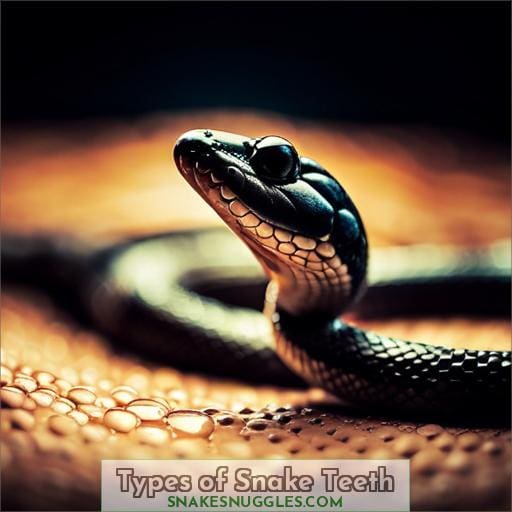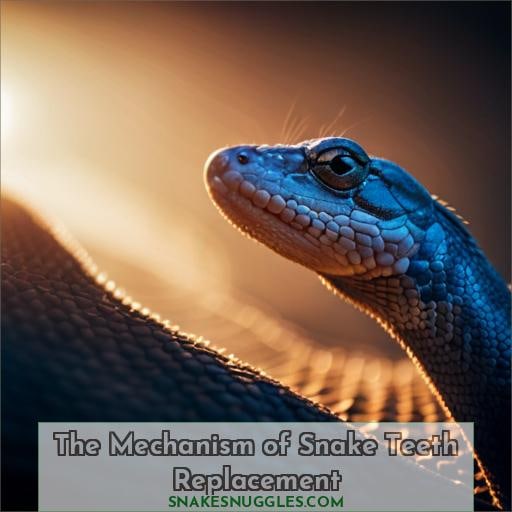This site is supported by our readers. We may earn a commission, at no cost to you, if you purchase through links.
 Take a closer look at snake fangs and teeth, and unlock the secrets of venomous serpents.
Take a closer look at snake fangs and teeth, and unlock the secrets of venomous serpents.
Discover how these syringe-like fangs have evolved to deliver venom with precision, allowing snakes to quickly immobilize their prey.
From the bevelled tips to the pressure-driven delivery system, delve into the fascinating world of snake dentition.
Explore different types of teeth and their adaptations based on diet, as well as the evolutionary significance behind these lethal weapons.
Get ready for a gripping journey into the realm of deadly serpents.
Table Of Contents
- Key Takeaways
- Snake Fangs and Teeth: an Overview
- Types of Snake Teeth
- Variations in Snake Teeth
- The Mechanism of Snake Teeth Replacement
- The Myths and Facts About Snake Jaw Flexibility
- The Evolutionary Significance of Snake Fangs and Teeth
- Applications and Implications of Studying Snake Teeth and Fangs
- Frequently Asked Questions (FAQs)
- Conclusion
Key Takeaways
- Venomous adaptations in snake fangs and teeth aid in efficient prey capture.
- Snake teeth variations are closely correlated with their diets and feeding behaviors.
- Snake teeth replacement mechanism ensures constant functional teeth for hunting.
- The evolution of snake fangs and teeth provides insights into genetic, morphological, and ecological adaptations.
Snake Fangs and Teeth: an Overview
Take a closer look at the fascinating world of snake fangs and teeth. Venomous adaptations, dental diversity, evolutionary insights, fang development, and tooth replacement are all key aspects to explore.
Snake fangs have evolved as specialized structures for delivering venom efficiently during prey capture or defense. They come in various shapes and sizes depending on the species’ ecological niche and feeding habits.
Fangs can be long and hollow like syringes or possess grooves for slow venom release during bites. Additionally, snakes are polyphyodonts, constantly replacing their teeth throughout their lives to ensure a constant set of functional weapons for hunting success.
Studying snake fangs provides valuable information about the evolution of these remarkable adaptations over time through comparative analysis among different species. Ecological research has shed light on how tooth shape correlates with diet specialization in snakes while revealing intriguing patterns of dental variation across diverse habitats worldwide.
Understanding snake fang development not only offers biological insights but also presents potential applications in medical fields such as drug delivery systems inspired by nature’s efficient venom injection mechanism.
In summary,
the intricate world of snake fangs
provides an abundance
of knowledge waiting to be unraveled.
From their diverse forms
to the way they evolve,
snake teeth offer invaluable clues
about nature’s ingenuity.
By delving into this subject further,
you will gain mastery over one aspect
of these captivating creatures’ power.
Types of Snake Teeth
Now let’s dive into the different types of snake teeth.
Snakes have a variety of tooth structures that serve different purposes. These include:
- Aglyphous teeth, which are long and thin but lack venom delivery capability;
- Solenoglyphous teeth, prominent fangs found in pit vipers that can retract and inject venom;
- Proteroglyphous teeth, located at the front of the mouth without a retractable mechanism;
- Opisthoglyphous teeth, situated near the back of the mouth for maximizing venom delivery while holding onto prey.
Understanding these variations in snake dental anatomy helps shed light on their feeding behaviors and adaptations.
Aglyphous Teeth
Now let’s delve into the world of snake teeth by exploring aglyphous teeth, a type of snake tooth found in various species.
- Aglyphous teeth lack venom delivery capability.
- They’re long, thin, and conical in shape.
- Examples include rat snakes and boa constrictors.
- Aglyphous adaptations suggest different strategies for capturing prey.
Solenoglyphous Teeth
You’ll find solenoglyphous teeth, characterized by their prominent fangs at the front of the mouth, in pit vipers like rattlesnakes. These specialized teeth are crucial for venom delivery and have unique 3D shapes that provide evolutionary insights into dental adaptations influenced by ecological factors.
Proteroglyphous Teeth
In the world of venomous serpents, a defining feature is their possession of proteroglyphous teeth. These specialized dental adaptations play a crucial role in venom delivery and have intriguing evolutionary origins.
Phylogenetic insights reveal the influence of ecological factors on fang penetration during snake bites.
Opisthoglyphous Teeth
Continuing our exploration of snake teeth, let’s now turn our attention to opisthoglyphous teeth.
These rear-located fangs are found in certain snake families and play a crucial role in venom delivery, prey capture, dietary adaptations, and tooth evolution among venomous serpents.
Variations in Snake Teeth
Let’s explore the fascinating variations in snake teeth, specifically focusing on tooth adaptations based on diet and specialized dental characteristics.
Snakes exhibit a wide range of tooth variations to suit their specific dietary needs, with some species having unique adaptations for consuming snails or reptile eggs.
Additionally, snakes are polyphyodonts, constantly replacing lost or damaged teeth to maintain functionality and efficiency in capturing prey.
By understanding these variations in snake teeth, we can gain deeper insights into the diverse dental characteristics found among different snake species.
Tooth Variations Based on Diet
Now let’s delve deeper into the variations in snake teeth, specifically focusing on how tooth number and placement can vary based on a snake’s diet.
The dietary preferences of snakes play a crucial role in shaping their dental anatomy. Snakes that primarily feed on small prey such as insects or fish tend to have numerous small teeth for grasping and swallowing their prey whole.
In contrast, snakes that consume larger prey like mammals or birds may have fewer but larger teeth designed for gripping and tearing apart their food.
Additionally, some species exhibit specialized adaptations in tooth shape and size to accommodate specific diets, such as elongated fangs for injecting venom into their victims or sharp rearward-facing teeth ideal for holding onto slippery fish.
Furthermore, snakes are polyphyodonts – constantly replacing lost or damaged teeth throughout their lifetime to ensure efficient feeding capabilities remain intact.
Tooth Adaptations for Special Diets
As we delve deeper into the variations in snake teeth, let’s explore the fascinating tooth adaptations that snakes have developed for special diets.
These adaptations are a result of adaptive morphology and dental evolution, allowing snakes to specialize in different types of prey.
The functional diversity of snake teeth is truly remarkable, with each species having unique dental structures suited to their specific diet-related adaptations.
From sharp fangs for capturing and injecting venom into prey to specialized teeth for crushing eggs or snails, snakes have evolved an array of tooth adaptations that showcase their mastery over their chosen diet.
The Mechanism of Snake Teeth Replacement
To understand how snakes maintain their sharp teeth, let’s take a closer look at the mechanism of snake tooth replacement.
Snakes have an incredible dental adaptation known as polyphyodonty, which allows for ongoing replacement of their teeth throughout their lives. This process ensures that they always have functional and sharp teeth for capturing and consuming prey.
Unlike humans who only go through two sets of permanent teeth, snakes continuously regrow new teeth to replace any lost or damaged ones. When a tooth is lost or broken during feeding or defense, it’s quickly replaced by another tooth in the same position within just a few days.
This continuous regrowth enables snakes to maintain optimal dental health and function without experiencing long-term issues with tooth loss. It supports their carnivorous lifestyle by ensuring efficient prey capture and consumption.
The mechanism of snake tooth replacement involves functional regeneration where old teeth are shed while new ones emerge from beneath the gums. This ongoing renewal process allows snakes to possess a constant set of sharp and effective weapons in their mouths.
In conclusion, the mechanism of snake tooth replacement is a remarkable dental adaptation that facilitates ongoing renewal and continuous regrowth of functional teeth in these venomous serpents.
The Myths and Facts About Snake Jaw Flexibility
Continuing our exploration of snake anatomy, let’s address some common misconceptions surrounding the flexibility of a snake’s jaw.
Contrary to popular belief, snakes don’t unhinge their jaws when consuming prey. Instead, their skulls possess biomechanical adaptations that allow for impressive skull flexibility and wide mouth opening.
Ligament function plays a crucial role in this process by connecting various skull pieces and providing elasticity. This remarkable adaptability enables snakes to consume prey larger than their own heads, showcasing the efficiency with which they capture and devour meals.
It is important to clarify that although snakes have flexible jaws, they can’t dislocate or detach them from their skulls as often portrayed in movies or folklore. The stretchy ligaments provide the necessary give without compromising structural integrity.
Understanding these facts about snake jaw flexibility helps dispel myths while shedding light on the incredible biomechanics behind this aspect of serpent anatomy.
The Evolutionary Significance of Snake Fangs and Teeth
To understand the evolutionary significance of snake fangs and teeth, let’s take a closer look at how these remarkable adaptations have shaped the survival and predatory success of venomous serpents.
- Evolutionary trajectories: Snake fangs and teeth have undergone fascinating evolutionary trajectories, adapting to different ecological niches.
- Developmental markers: By studying developmental markers like tooth-forming epithelium in snake embryos, scientists gain insights into the genetic modularity underlying fang development.
- Phylogenetic insights: Comparisons between species provide valuable phylogenetic insights into the evolution of venom delivery systems and tooth structures.
These findings shed light on how snakes evolved their specialized dental features for efficient venom delivery during predation. Understanding this complex interplay between genetics, morphology, ecology can help us appreciate nature’s ability to shape extraordinary adaptations that enhance an organism’s power over its environment.
Applications and Implications of Studying Snake Teeth and Fangs
By exploring the applications and implications of studying snake teeth and fangs, you gain valuable insights into the evolutionary significance of these unique anatomical structures.
The study of venom delivery mechanisms can provide a deeper understanding of how snakes have evolved to effectively inject their potent venoms into prey or potential threats. By examining dental adaptations in venomous serpents, researchers can uncover evolutionary patterns that shed light on how these specialized structures have developed over time.
These findings not only contribute to our knowledge of snake evolution but also have medical insights for developing antivenom treatments and understanding human health conditions related to tooth development.
Additionally, studying snake teeth and fangs allows us to appreciate their ecological impact as efficient predators in various ecosystems around the world.
Frequently Asked Questions (FAQs)
How do snake fangs differ from regular snake teeth?
Snake fangs, unlike regular snake teeth, are specialized structures designed for venom delivery.
They can be hollow or grooved depending on the species and are located in the front part of the jaw for efficient prey immobilization.
Are there any differences in tooth placement based on a snake’s diet?
When it comes to a snake’s diet, tooth placement varies to suit its culinary preferences.
Some snakes have more teeth on one side for snail consumption, while others develop an extra tooth in the back of their jaw for devouring reptile eggs.
How do snakes replace their lost or damaged teeth?
Snakes have a remarkable ability to replace their lost or damaged teeth.
Through a rapid tooth replacement mechanism, snakes ensure they always have sharp and functional teeth, supporting their carnivorous lifestyle and efficient prey capture.
Can snakes unhinge their jaws to consume large prey?
Do snakes truly unhinge their jaws?
While it may seem like it, the reality is that snakes have flexible skulls and stretchy ligaments that allow them to open their mouths wide enough to consume prey larger than their heads.
What is the evolutionary significance of snake fangs and teeth?
Snake fangs and teeth have evolved for efficient prey capture.
Fangs vary in type, such as solenoglyphous (retractable) or proteroglyphous (non-retractable), delivering venom to immobilize prey.
Tooth variations exist based on diet, with snakes constantly replacing lost teeth through polyphyodonts mechanism.
Conclusion
To truly understand the remarkable world of venomous serpents, one must delve into the intricate details of snake fangs and teeth.
These syringe-like fangs have evolved with precision, enabling snakes to immobilize their prey swiftly.
From the adaptations based on diet to the mechanism of tooth replacement, snake dentition holds fascinating secrets waiting to be discovered.
Exploring the evolutionary significance of these lethal weapons provides insight into the remarkable survival strategies of these deadly creatures.
So, take a closer look at snake fangs and teeth, and unlock the secrets of venomous serpents.













